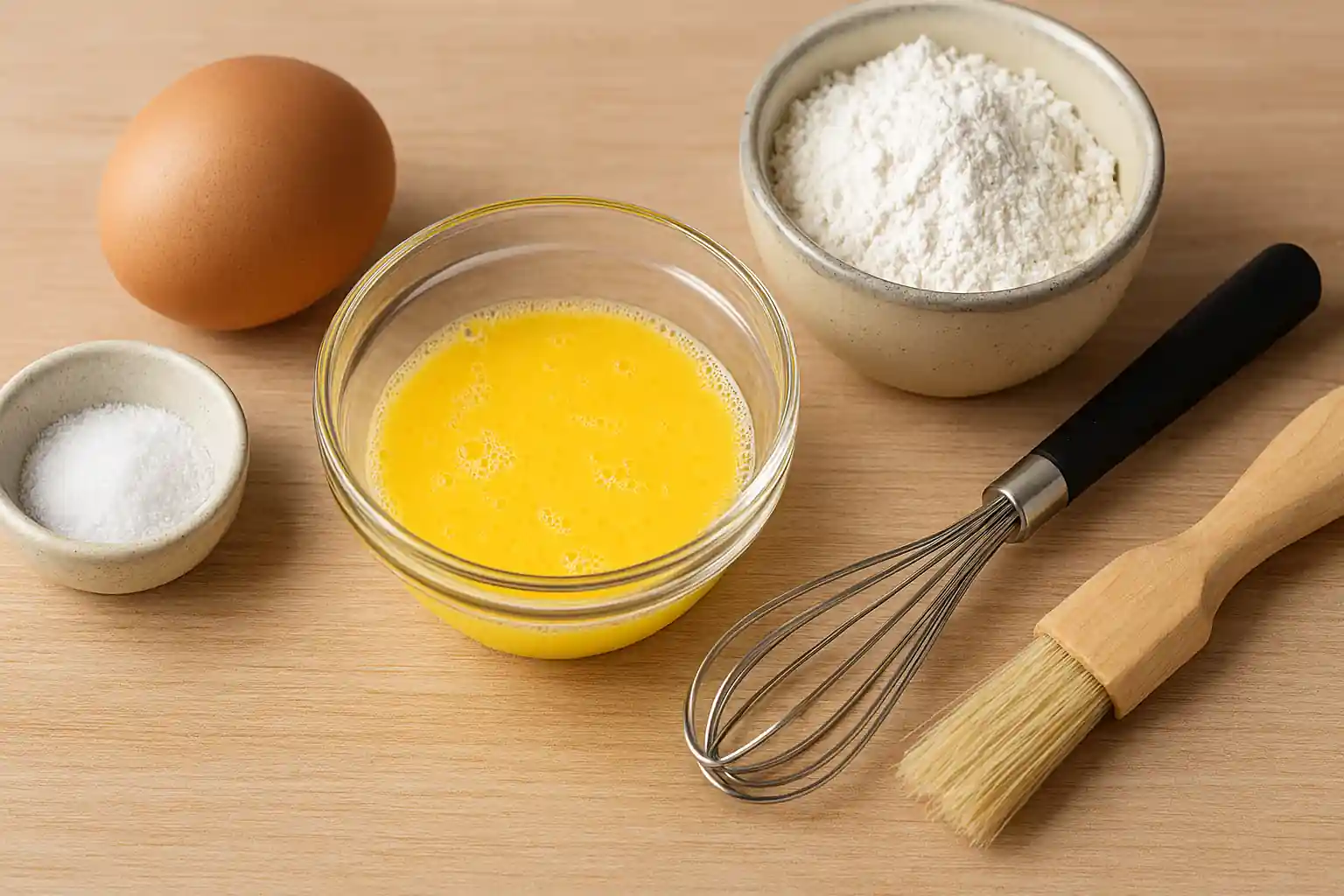Egg Wash Recipe: The Complete Guide for Perfect Pastries and Baked Goods
When it comes to baking, there are certain techniques that instantly elevate the final look and texture of your desserts and breads. Among those techniques, nothing is simpler yet more impactful than using an egg wash. A basic egg wash recipe can transform an ordinary pastry or pie crust into a golden brown, glossy masterpiece. Whether you are preparing a pie, a scone, puff pastry, or even dinner rolls, learning how to make egg wash and when to use it can make all the difference.
This in-depth guide covers everything you need to know about egg wash: the ingredients, different variations, how to apply it correctly, recipe tips, substitutes, and common mistakes to avoid. By the end, you’ll understand why every professional pastry chef considers egg wash the perfect finishing touch for baked goods.
Egg Wash
Egg wash is simply a mixture made from beaten egg and a liquid such as water, milk, or cream. It is brushed onto baked goods before baking to create a golden brown crust, help toppings stick, or seal pastry edges. While it may sound basic, egg wash is a fundamental tool in baking and pastry work.
The proteins in the egg are responsible for the golden color and sheen, while the liquid element helps dilute the egg, ensuring the mixture can be brushed in a thin, even layer. When you use egg wash correctly, your baked good comes out of the oven with that deep golden brown color everyone loves.
Basic Egg Wash
A basic egg wash is made from one large egg beaten with a tablespoon of liquid. The most common options are water, milk, or cream. The liquid you choose will influence the final texture and shine of your baked goods:
-
Egg and water: Produces a crisp finish with moderate shine.
-
Egg and milk: Results in a golden color with more sheen.
-
Egg and heavy cream: Creates a rich, deep golden brown crust with a soft, glossy appearance.
Whether you are making a pie crust, scone recipes, puff pastry, or croissants, the basic egg wash recipe remains the same—just whisk the egg and liquid together until smooth.
Egg Wash Recipe
To make egg wash, you need only a few simple ingredients and tools:
Egg Wash Ingredients
-
One egg (whole egg, egg yolk, or egg white depending on preference)
-
1 tablespoon liquid (milk, water, or cream)
-
A pinch of salt (optional, enhances color and consistency)
-
A whisk or fork
-
A pastry brush (preferably silicone pastry brush for even application)
Basic Egg Wash Recipe
-
Crack one large egg into a small bowl.
-
Add 1 tablespoon of your chosen liquid (milk or water are common).
-
Whisk until the egg mixture is smooth and well blended.
-
Dip your silicone pastry brush or natural bristle brush into the mixture.
-
Brush the egg wash in a thin, even layer onto your pastry dough, pie crust, or scone right before baking.
This simple method is the foundation of countless desserts and baked goods.
Use Egg Wash
Bakers use egg wash in many different ways:
-
To create a golden brown crust – Brushing the mixture onto baked goods before baking ensures they come out with a beautiful golden finish.
-
To act as a glue – Egg wash is perfect for sealing pastry edges, such as in hand pies, croissants, or puff pastry.
-
To attach toppings – If you want sesame seeds, sugar crystals, or herbs to stick to a crust, brushing on an egg wash first is essential.
-
To prevent sogginess – Applying an egg wash inside a pie crust before adding filling helps act as a barrier, preventing juices from making the crust soggy.
Ways to Use Egg Wash
Egg wash isn’t just for pies—it is versatile across many types of baked goods:
-
Pie crust: Adds shine and a golden color.
-
Scones: Brushed lightly for a crisp and beautiful finish.
-
Croissant: Essential for that signature glossy exterior.
-
Dinner rolls: Creates a soft, golden brown top.
-
Hand pies: Acts as glue for pastry edges while also improving color.
-
Puff pastry: Ensures layers bake to a golden brown and remain flaky.
-
Pumpkin pie or fruit pie: Enhances the crust’s appeal and durability.
By brushing the egg wash right before baking, you can ensure your baked goods go into the oven looking ordinary and come out extraordinary.
Different Types of Egg Wash
The final appearance of your baked goods depends on the type of egg wash you use:
-
Whole egg and water: Golden color with moderate shine.
-
Whole egg and milk: Golden color with more sheen.
-
Egg yolk and cream: Deep golden brown color, very glossy.
-
Egg white and water: Pale, shiny finish; good for sealing edges without much browning.
-
Egg yolk and water: Rich color, slightly less glossy than cream.
Experimenting with these variations helps you find the best egg wash for each recipe.
Pastry
Professional pastry chefs rely on egg wash to give desserts and baked goods a polished look. Whether working with puff pastry, croissants, or layered pastry dough, applying egg wash in a thin, even layer ensures that each baked good has a golden brown and appetizing crust.
Pastry edges can be sealed effectively with egg wash, preventing filling from leaking during baking. This is particularly important for hand pies, fruit pies, and turnovers.
Pie
Egg wash for pie crusts is a traditional baking practice. Applying a basic egg wash recipe onto your pie crust before baking ensures a golden, crisp, and shiny surface. For pumpkin pie or fruit pie, brushing the egg wash onto the edges provides a beautiful golden rim that frames the dessert.
Some bakers also brush an egg wash inside the pie crust before adding filling. This trick acts as a barrier, preventing excess moisture from making the crust soggy.
Egg Wash for Bread
When preparing dinner rolls, sandwich bread, or a roll recipe, egg wash helps give the bread a glossy, golden color. For breads sprinkled with seeds or herbs, brushing the egg wash ensures the toppings adhere to the surface.
Perfect Egg Wash
The secret to a perfect egg wash lies in balance. The mixture must not be too thick, as this will create streaks, nor too thin, as it will fail to give color. Always whisk until smooth and apply an even layer using a silicone pastry brush.
Apply egg wash right before baking for the best results. If applied too early, it may soak into the dough, preventing that beautiful golden finish.
Puff Pastry
Puff pastry is one of the most common uses for egg wash. Whether making croissants, turnovers, or savory puffs, brushing egg wash onto puff pastry gives it a rich, golden brown appearance and helps layers puff beautifully.
Scone
In scone recipes, egg wash helps create a crisp and shiny top crust. Brushing the wash onto scones right before baking adds color and makes them look bakery-quality.
Egg Wash Substitutes
If you don’t want to use egg or have dietary restrictions, there are several egg wash substitutes:
-
Milk or cream: Produces a pale golden finish, though less shiny.
-
Almond milk: A dairy-free option that works well on scones and breads.
-
Melted butter: Adds flavor and helps browning.
-
Oil: Provides shine but not much color.
-
Honey water or sugar water: Adds sweetness and color for desserts.
While these substitutes can be effective, the best egg wash remains the traditional beaten egg mixture.
Perfect Finishing Touch
Adding an egg wash is the perfect finishing touch for desserts and baked goods. It ensures your baked goods come out with a golden brown crust, a glossy finish, and professional appeal. Whether you’re sealing pastry edges, brushing onto pie crust, or finishing off a croissant, egg wash enhances both function and beauty.
Recipe Tips
-
Always whisk the egg and liquid until completely smooth.
-
Use a silicone pastry brush for even application.
-
Apply egg wash right before baking, not too early.
-
Avoid applying too thick of a layer—use an egg wash in a thin, even layer.
-
Store leftover egg wash in an airtight container in the fridge for up to 3 days.
-
Adding a pinch of salt enhances the mixture and color.
Recipe FAQs
Can I make egg wash ahead of time?
Yes, store it in the fridge in an airtight container for up to 3 days.
What if I don’t have a pastry brush?
You can use silicone, natural bristle, or even a clean paper towel in a pinch.
What’s the best egg wash for pie crust?
A beaten whole egg with milk or cream provides the best egg wash for pie crust with a golden, glossy finish.
Can I use just egg yolk?
Yes, egg yolk mixed with cream creates the richest golden brown color.
Can I use just egg white?
Yes, egg white and water provide shine without much browning.
Is egg wash necessary?
Not always, but it adds professional quality and enhances the appearance of baked goods.
Looking for a creamy, flavorful classic? Try this Best Classic Egg Salad Recipe—perfect for sandwiches, snacks, or a light lunch!
Conclusion
Egg wash is one of the simplest yet most effective techniques in baking. From pies and pastries to breads and scones, knowing how to make egg wash and when to use it helps every baked good look and taste better. Whether you follow the basic egg wash recipe or experiment with different types of egg wash, this versatile mixture adds a golden color, glossy finish, and acts as a functional barrier or glue.
So, the next time you prepare a pie crust, puff pastry, or dinner rolls, remember to brush the egg wash right before baking. It’s the small detail that transforms your baked goods from homemade to bakery-quality, making egg wash the true perfect finishing touch.

